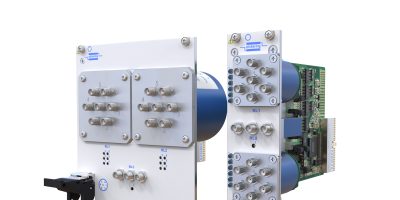40/42-890 family brings configurable microwave switching to PXI
Configurable microwave switches in the 40/42-890 family of modular, flexible PXI/PXIe microwave switches introduce switching at up to 110GHz to the PXI platform.
The switches debuted at AutoTestCon 2023, the IEEE’s annual conference for the military/aerospace automatic test industry in Maryland, USA (28 to 31 August).
The configurable switches will support the latest and most demanding RF and communications test requirements as operating frequencies continue to evolve to ever higher levels.
Suitable for test environments requiring high frequency microwave switching, from radar, satellite and short-range land-based secure communications to consumer electronics and 5G infrastructure, the 40/42-890 microwave switch family allows RF test engineers to “select from and combine a wide range of high performance microwave relay types to suit their exact application requirements, explained Steve Edwards, switching product manager at Pickering. At the same time, they minimise chassis slot usage by combining multiple relay and connector types on a single module, he added.
A range of SPDT, SPnT, and transfer switch types are offered in PXI/PXIe, with terminated or unterminated ports at frequencies up to 110GHz. Options are available in 50 or 75 Ohm impedance. RF test engineers can specify the combination and topology of relays needed to create a bespoke solution for their application requirements. Switching systems also benefit from reduced chassis slot count since multiple relay types can be combined in a single module. This helps minimise cost by combining the switch payload onto a smaller number of modules when compared to single switch type products, advised Pickering.
This ability to combine a mix of relay types allows users to create larger and/or higher frequency multiplexers (MUXs) than offered via dedicated switches. For example, by combining two SP6T terminated and one SPDT relay, users can, with the addition of linking cables, create an SP12T terminated MUX rated to frequencies exceeding the 18GHz offered via dedicated switches.
Pickering also offers a range of pre-defined models, offered as standard. With PXI or PXIe control interface options, test engineers also benefit from flexibility in chassis selection, said Pickering. Its connection division can provide a full range of cabling to support the 40/42-890 range.
Each relay fitted to a 4x-890 module has associated front panel LED indicators to show the current energised path. This signal path indication provides a clear visual confirmation for verifying system operation, simplifying the debugging of test application software. On-board relay counting is also offered, allowing the quantity of switching operations to be monitored as part of a test system predictive maintenance process. Relay types can be quickly replaced by simply withdrawing them through the front panel, to accelerate in-field repair.
Test engineers can configure front panel layouts for the 4x-890 family using Pickering’s free web-based Microwave Switch Design Tool (MSDT), selecting panel size, relay types, LED indicators, cooling slots, images, and labelling. The user can position the selected panel elements as required before submitting them to Pickering for production. The 4x-890 modules are also supplied with soft front panels for each fitted relay, enabling manual control of the switches. This simplifies application software development and debug.
The 40/42-890 range is supplied with drivers that enable support across all popular software programming environments and operating systems, including Windows and Linux, as well as other real-time hardware-in-the-loop (HIL) tools.




